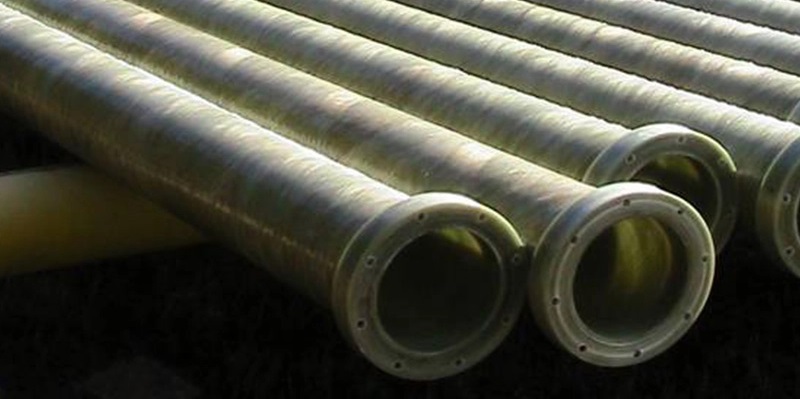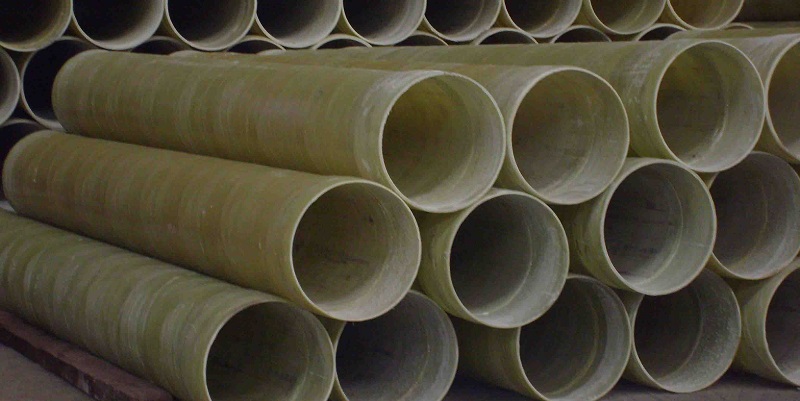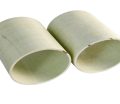
FRP pipe MSDS (Material Safety Data Sheet) is an essential document that provides important safety and regulatory information for handling FRP (Fiberglass Reinforced Plastic) pipes. It outlines the composition of the materials used in FRP pipes, including resins, fiberglass reinforcement, and other additives. FRP pipe MSDS helps workers and engineers understand the potential hazards, such as dust inhalation during cutting or exposure to chemicals. It also provides guidelines for personal protective equipment (PPE), safe handling practices, fire safety, and first aid measures in case of accidents. By following FRP pipe MSDS, industries can ensure proper safety measures and compliance with regulations in their work environments. The FRP pipe MSDS details first aid for dust inhalation and skin contact, ensuring safety and reducing environmental impact.
How about FRP Pipe MSDS
FRP pipe MSDS (Material Safety Data Sheet) is a critical document that provides essential information regarding the safe handling, use, and disposal of fiber-reinforced plastic (FRP) pipes. It outlines the potential hazards associated with FRP products, along with safety precautions, first aid measures, and proper storage guidelines. GangLong Fiberglass ensures that the FRP pipe MSDS is readily available to guide workers, safety officers, and emergency responders in the safe management of FRP products throughout their lifecycle. Understanding the content of an FRP pipe MSDS is crucial for maintaining a safe work environment and minimizing risks associated with the handling of FRP materials.

What is an MSDS?
MSDS, or Material Safety Data Sheet, is a document designed to provide comprehensive information about the hazards of a chemical or chemical mixture. Required by chemical manufacturers for all their products, MSDSs contain critical details such as the product’s identification, hazardous ingredients, physical and chemical properties, fire and explosion hazards, reactivity, toxicological effects, preventive measures, and first aid instructions.
These documents are intended to help employees and emergency responders safely handle hazardous substances. Employers must maintain accessible copies of MSDSs for each chemical in the workplace and ensure availability to employees during every shift.
Although MSDSs have now been replaced by Safety Data Sheets (SDSs), the purpose remains the same. SDSs follow a standardized 16-section format to ensure uniformity and improve usability, enhancing workplace safety and compliance with global standards.
What are the Hazard Identification Details in FRP Pipe MSDS?
FRP pipe MSDS contains a section dedicated to hazard identification, which outlines the potential health and safety hazards associated with FRP products. This section is vital for understanding the risks that workers may encounter when handling or processing FRP pipes.
- Potential Health Hazards
The primary health hazards associated with FRP pipes are related to dust and particulate matter generated during cutting, grinding, or machining processes. Inhalation of dust can cause respiratory irritation or discomfort, especially in individuals with pre-existing respiratory conditions. The MSDS will typically highlight these risks and recommend appropriate personal protective equipment (PPE) such as masks or respirators to minimize exposure. - Skin and Eye Irritation
FRP pipe MSDS may also indicate that direct contact with dust, fibers, or resin components can cause skin or eye irritation. Skin contact with fibers can lead to itching or redness, while eye contact with dust or particles can cause discomfort or inflammation. The MSDS emphasizes the importance of wearing protective gloves, clothing, and safety goggles to prevent such incidents. - Chemical Hazards
FRP pipes are made using various resins and additives that may pose chemical hazards, particularly during the manufacturing or processing stages. These hazards may include the potential for exposure to volatile organic compounds (VOCs) or other chemicals used in the production of FRP pipes. The MSDS will provide information on the nature of these chemical hazards and recommend safety measures to mitigate exposure risks.
First Aid Measures in FRP Pipe MSDS
FRP pipe MSDS includes detailed first aid measures to be followed in case of exposure to hazards such as inhalation of dust, skin contact, or eye contact. These measures are designed to reduce the severity of any health effects and promote the safety of individuals who may be exposed to FRP materials.
- Inhalation of Dust
If an individual inhales dust generated during the cutting, grinding, or machining of FRP pipes, they may experience respiratory irritation. The FRP pipe MSDS will advise moving the affected person to fresh air immediately. If breathing difficulties persist, it may recommend seeking medical attention. The use of appropriate respiratory protection, such as N95 masks or respirators, is also emphasized to prevent inhalation of dust in the first place. - Skin Irritation
Contact with FRP dust or fibers can cause skin irritation, such as itching or redness. The first aid measures in the FRP pipe MSDS suggest washing the affected area thoroughly with soap and water. Avoid rubbing the skin, as this can aggravate the irritation. If symptoms persist, the MSDS may recommend consulting a healthcare professional. Wearing protective gloves and clothing can help prevent skin irritation during the handling and processing of FRP pipes. - Eye Contact
If FRP dust or particles come into contact with the eyes, they can cause irritation, redness, or a foreign body sensation. The FRP pipe MSDS instructs to flush the eyes immediately with plenty of water for several minutes, keeping the eyelids open to ensure thorough rinsing. If irritation persists after rinsing, it advises seeking medical attention. The use of safety goggles or face shields is strongly recommended to protect the eyes when working with FRP materials. - Ingestion
While ingestion of FRP dust or particles is unlikely, the MSDS will still provide guidance in such situations. If ingestion occurs, the MSDS typically advises rinsing the mouth with water and seeking medical advice. It is important to avoid inducing vomiting unless instructed by medical personnel. Proper hygiene practices, such as washing hands before eating or drinking, can help prevent accidental ingestion.
Firefighting Measures in FRP Pipe MSDS
FRP pipe MSDS includes information on firefighting measures due to the presence of resins and other organic materials that can contribute to combustion. This section outlines the appropriate methods and equipment for extinguishing fires involving FRP pipes.
- Suitable Extinguishing Media
The MSDS will specify the appropriate extinguishing media for fires involving FRP pipes. Common extinguishing agents include water spray, foam, dry chemical powder, or carbon dioxide (CO2). Using the correct extinguishing media is crucial for effectively suppressing the fire and preventing its spread. - Special Hazards Arising from the Material
In the event of a fire, FRP pipes may produce hazardous combustion products such as carbon monoxide, carbon dioxide, and other toxic gases. The MSDS will highlight these hazards and advise firefighters to wear self-contained breathing apparatus (SCBA) and full protective clothing to minimize exposure to smoke and toxic fumes. - Firefighting Instructions
The MSDS provides specific instructions for firefighting procedures, including the importance of maintaining a safe distance from the fire and using water spray to cool surrounding areas. It may also recommend evacuating personnel from the area if the fire poses a risk to human health or safety. Proper ventilation of the area after the fire is extinguished is essential to disperse any residual fumes or smoke.
Fire and Explosion Data in FRP Pipe MSDS
While FRP pipes are known for their fire resistance, certain conditions may still pose fire risks, particularly if they are exposed to high temperatures or open flames. The FRP pipe MSDS provides detailed information on fire safety and the precautions that should be taken in the event of a fire.
FRP pipes are generally resistant to ignition due to the nature of the polymer resin used in their construction. However, if exposed to extremely high temperatures, such as during a fire, the resin may begin to break down and release toxic gases like carbon monoxide (CO) or carbon dioxide (CO₂). For this reason, it is important to ensure that FRP pipes bridge are not installed near sources of open flame or extreme heat without appropriate fireproofing.
The FRP pipe MSDS recommends using suitable fire extinguishing methods, such as water, carbon dioxide (CO₂), or dry chemical extinguishers, in the event of a fire involving FRP pipes. Firefighters should also wear self-contained breathing apparatus (SCBA) to protect themselves from inhaling any harmful gases that may be released during combustion.
The Key of Fire Safety and Ventilation When Handling FRP Pipes
Fire safety and proper ventilation are crucial aspects of working with FRP pipes. Although FRP is resistant to ignition, the materials used in its construction can release toxic gases if exposed to high heat or flames. As outlined in the FRP pipe MSDS, it is essential to install and use FRP pipes in environments where the risk of fire is minimized.
Proper ventilation systems should be used when cutting, drilling, or sanding FRP pipes to ensure that dust and fumes are removed from the workspace. Adequate ventilation not only protects workers from inhaling hazardous particles but also reduces the risk of fire by preventing the accumulation of flammable dust.
Fire extinguishers should be easily accessible in areas where FRP pipes are being installed or worked on. Workers should be trained in how to use these extinguishers and understand the procedures outlined in the FRP pipe MSDS for responding to fire-related incidents.
By following the guidelines provided in the FRP pipe MSDS, workers and engineers can ensure that FRP pipes are handled safely and effectively, minimizing health risks and ensuring compliance with safety regulations.
Fire and Explosion Data for FRP Pipe MSDS
FRP pipe MSDS provides crucial information on the fire and explosion risks associated with FRP pipes. While FRP pipes are generally resistant to combustion, the resins and other organic components can contribute to fire under certain conditions. This section guides emergency response teams on how to manage fire-related incidents involving FRP pipes.
- Flash Point
The flash point is the lowest temperature at which the vapors of a material can ignite in the presence of an ignition source. FRP pipes, specifically the resin component, can have varying flash points depending on the type of resin used. For instance, polyester resins typically have flash points in the range of 31-33°C (88-91°F). The FRP pipe MSDS provides specific flash point information, helping emergency responders understand the potential flammability of the material. - Fire and Explosion Hazards
Although FRP pipes are designed to be flame-retardant, they can still present fire hazards when exposed to open flames or high heat. The combustion of FRP pipes can produce hazardous gases such as carbon monoxide, carbon dioxide, and other toxic fumes. The MSDS highlights these potential hazards and stresses the importance of using proper firefighting equipment and procedures to handle fires involving FRP pipes safely. - Firefighting Measures
The FRP pipe MSDS outlines appropriate firefighting measures for extinguishing fires involving FRP pipes. Suitable extinguishing media include water spray, foam, dry chemical powder, and carbon dioxide (CO2). The MSDS advises using water spray to cool adjacent structures and materials to prevent the spread of fire. Firefighters should wear full protective clothing and self-contained breathing apparatus (SCBA) to protect themselves from heat, flames, and toxic fumes. The MSDS also emphasizes maintaining a safe distance and avoiding direct contact with burning material to minimize the risk of injury.
Handling and Storage Guidelines in FRP Pipe MSDS
Proper handling and storage of FRP pipes are crucial for maintaining safety in the workplace and ensuring the longevity of the products. The FRP pipe MSDS provides guidelines for safely handling and storing these materials.
- Safe Handling Practices
The MSDS advises on safe handling practices to minimize exposure to hazards associated with FRP pipes. This includes using appropriate PPE, such as gloves, masks, and safety glasses, when cutting, grinding, or performing other tasks that generate dust. Workers should be trained on the safe handling of FRP pipes and the importance of using tools and equipment designed for working with FRP materials to reduce the risk of injury. - Proper Storage Conditions
The MSDS outlines the ideal storage conditions for FRP pipes to prevent damage and degradation. FRP pipes should be stored in a cool, dry, and well-ventilated area, away from direct sunlight and sources of heat or ignition. Stacking should be done in a manner that prevents crushing or deformation of the pipes. Proper storage helps maintain the integrity and performance of the FRP pipes over time. - Spill and Leak Procedures
Although FRP pipes do not typically pose a risk of spills or leaks, the MSDS may include procedures for managing situations where dust or debris is released. This section advises on using dust control measures, such as wetting down the area to reduce airborne particles, and using appropriate cleaning equipment to collect and dispose of the material safely.

Exposure Controls and Personal Protection in FRP Pipe MSDS
The use of proper personal protective equipment (PPE) is one of the most critical safety measures outlined in the FRP pipe MSDS. To minimize the risk of exposure to fiberglass dust, workers must wear appropriate PPE during the installation, cutting, or sanding of FRP pipes.
Safety goggles or face shields are necessary to protect the eyes from dust and debris. Even small amounts of fiberglass dust can cause irritation or injury if they come into contact with the eyes. Respiratory protection is equally important, particularly in environments where dust concentrations are high or ventilation is limited. NIOSH-approved dust masks or respirators should be worn to prevent inhalation of fiberglass particles.
Gloves should be used to protect the skin from direct contact with fiberglass and resin, both of which can cause irritation. Additionally, workers should wear long sleeves and coveralls to limit skin exposure. Protective clothing can be especially important when working in confined spaces or during prolonged handling of FRP materials.
The FRP pipe data MSDS also recommends that workers regularly wash their hands and face after handling FRP materials, especially before eating or drinking. This helps to prevent the ingestion of any residual dust or particles that may have settled on the skin.
Engineering Controls
The MSDS recommends implementing engineering controls to reduce exposure to FRP dust and fumes. This may include using local exhaust ventilation (LEV) systems to capture dust at the source during cutting, grinding, or sanding operations. Proper ventilation helps maintain air quality in the work area and reduces the concentration of airborne particles.
Personal Protective Equipment (PPE)
The use of appropriate PPE is crucial for protecting workers from exposure to FRP dust, fibers, and chemicals. The MSDS specifies the types of PPE required, including:
- Respiratory Protection: N95 masks or respirators are recommended to prevent inhalation of dust and fibers.
- Eye Protection: Safety goggles or face shields protect the eyes from dust and particles.
- Skin Protection: Gloves and protective clothing prevent skin contact with fibers and dust. Workers should be trained on the proper use and maintenance of PPE to ensure effective protection.
Hygiene Measures
The MSDS emphasizes the importance of good hygiene practices when working with FRP pipes. Workers should wash their hands thoroughly after handling FRP materials, especially before eating, drinking, or smoking. Work areas should be kept clean, and contaminated clothing should be changed and washed to prevent skin irritation and reduce the risk of exposure.
Disposal Considerations in FRP Pipe MSDS
The FRP pipe MSDS provides guidance on the proper disposal of FRP materials to ensure compliance with environmental regulations and minimize environmental impact.
Waste Disposal
The MSDS outlines the procedures for disposing of FRP waste, including dust, offcuts, and damaged pipes. FRP waste should be collected and disposed of in accordance with local, regional, and national regulations. It may be classified as non-hazardous waste, but it is important to follow proper disposal practices to prevent environmental contamination.
Recycling and Reuse
Where possible, the MSDS may encourage recycling or reuse of FRP materials. Some FRP waste can be processed and repurposed for use in other products, reducing the need for new raw materials and minimizing waste generation. Recycling options should be explored to promote sustainability and reduce the environmental footprint of FRP products.
Avoiding Environmental Release
The MSDS advises on preventing the release of FRP dust and particles into the environment. This includes using dust control measures during processing and proper disposal of waste
Cutting FRP Pipe with Precision: Tools and Techniques to Use
Key Components of FRP Pipe MSDS
An FRP pipe MSDS contains several key sections, each of which provides important information about the product and how it should be handled safely. These sections include product identification, hazard information, and handling instructions. Understanding these components is crucial for ensuring that workers and engineers follow the proper safety protocols when working with fibercast FRP pipes.
The first section of the FRP pipe MSDS focuses on product identification. This section provides the name of the FRP pipe, its chemical family, and any relevant trade names. For example, a product like GangLong Fiberglass FRP pipe would be listed with its specific composition and use case in industrial environments. Knowing the specific product type is essential for determining the correct safety measures.
The next key component is the composition and information on ingredients. This section describes the materials used to manufacture the FRP pipe, including the types of resin (such as polyester or epoxy) and fiberglass used for reinforcement. This information is critical for assessing the potential risks and hazards that may arise during handling or installation.
Hazard identification is another crucial part of the FRP pipe MSDS. This section outlines the risks associated with the product, such as skin or eye irritation caused by exposure to fiberglass dust or fumes from the resin. By identifying these hazards, workers can take steps to protect themselves from injury or long-term health effects.
Hazards and Precautions for Handling FRP Pipes
Working with FRP pipes, especially during cutting, drilling, or installation, can present several potential hazards. The primary concern when handling FRP pipes is the production of fiberglass dust. This fine dust can become airborne during mechanical processes such as cutting or sanding, and if inhaled, it can cause respiratory irritation. Additionally, fiberglass dust may irritate the skin or eyes upon contact.
To mitigate these hazards, the FRP pipe MSDS recommends several precautions. One of the most important measures is the use of proper personal protective equipment (PPE). Workers should wear safety glasses or goggles to protect their eyes from dust, and gloves should be worn to prevent skin irritation. Respiratory protection, such as NIOSH-approved dust masks or respirators, is also essential to avoid inhaling fiberglass particles.
Another critical precaution outlined in the FRP pipe MSDS is the need for adequate ventilation. When working indoors or in enclosed spaces, proper ventilation systems should be used to ensure that fiberglass dust is removed from the air. This helps reduce the concentration of airborne particles, further minimizing the risk of inhalation.
It’s also important to handle FRP pipes with care to avoid physical damage that could weaken the pipe structure. Dropping or striking FRP pipes may cause cracks or chips, which could lead to structural failure. Workers should use appropriate lifting and handling techniques to prevent damage and maintain the integrity of the pipes.
Environmental Impact and Disposal Guidelines for FRP Pipes
The FRP pipe MSDS also addresses the environmental impact of FRP materials and provides guidance on how to dispose of them safely. While FRP is generally considered non-toxic once it is fully cured, incomplete curing of the resin can leave behind harmful residues that may pose environmental risks.

To minimize environmental impact, the FRP pipe MSDS recommends following local, provincial, or federal regulations when disposing of FRP materials. This includes ensuring that any waste from cutting or fabricating FRP pipes is properly contained and disposed of in designated industrial waste facilities. It is important to avoid disposing of FRP materials in general landfill sites, as this may contribute to environmental pollution.
Recycling FRP materials is another option that may be available in certain regions. However, the recycling of FRP is more complex than with traditional materials like steel or aluminum, and not all recycling centers are equipped to handle FRP. Therefore, it is essential to check with local authorities to determine the appropriate disposal or recycling procedures for FRP waste.
Deriving FRP Pipe Burst Pressure with Barlow’s Formula Explained
What are the Chemical Composition and Hazardous Ingredients in FRP Pipe MSDS?
The FRP pipe MSDS includes detailed information on the chemical composition of the FRP pipes, including the resins, fibers, and additives used in their production. This section helps identify any hazardous ingredients that may pose health or environmental risks.
Resin Matrix
FRP pipes are primarily made of a resin matrix, which acts as a binder for the reinforcing fibers. The resin is typically composed of polyester, vinyl ester, or epoxy, depending on the specific application and desired properties of the FRP pipe. The MSDS specifies the type of resin used and any associated hazards. For example, uncured resins can emit volatile organic compounds (VOCs) that may pose inhalation hazards. GangLong Fiberglass uses high-quality resins in the production of FRP pipes to minimize health and environmental risks.
Reinforcing Fibers
The reinforcing fibers in FRP pipes, usually glass fibers, provide structural strength and rigidity. While long glass fiber themselves is generally non-hazardous, the MSDS will indicate that dust generated from cutting, grinding, or sanding FRP pipes can cause respiratory irritation if inhaled. The document emphasizes the importance of using appropriate personal protective equipment (PPE) such as masks and respirators during such activities.
Additives and Fillers
Additives and fillers may be incorporated into the resin matrix to enhance the performance of FRP pipes. These substances can include pigments, flame retardants, and stabilizers. The FRP pipe MSDS lists these additives and highlights any potential hazards associated with their use. Safety measures, such as wearing gloves and using proper ventilation, are recommended to minimize exposure.
Essential FRP Pipe Code List for Engineers and Designers
FAQs about Frp Pipe Msds
FRP (Fiberglass Reinforced Plastic) is generally not considered hazardous in its finished form, as it is non-toxic, non-corrosive, and does not release harmful substances during normal use. However, there are some safety concerns related to the manufacturing and installation processes. During fabrication or cutting, FRP can release fine fiberglass particles, which may pose respiratory risks if inhaled. For this reason, it is important to wear proper personal protective equipment (PPE), such as masks, gloves, and eye protection, when handling FRP materials during installation or repairs.
Once installed, FRP is safe for use in a variety of applications, including industrial, marine, and public infrastructure. It is resistant to chemicals, fire, and extreme weather conditions, making it a preferred material for harsh environments. FRP also has the benefit of being non-conductive, which enhances safety in electrical applications. Proper handling during fabrication and adherence to safety guidelines ensures that FRP poses minimal health risks in its final application.
FRP pipe material refers to a composite made from fiberglass reinforced with a polymer resin. This material is created by combining strong glass fibers with a durable resin matrix, usually polyester, vinyl ester, or epoxy. The glass fibers provide the pipe with strength and rigidity, while the resin adds flexibility and resistance to environmental factors such as chemicals, UV light, and moisture. Together, these materials create a pipe that is lightweight, strong, and highly durable.
FRP pipes are known for their ability to withstand corrosion, making them suitable for use in industries like chemical processing, wastewater treatment, and marine environments. Unlike traditional metal pipes, FRP pipes do not rust or corrode when exposed to water or harsh chemicals, which significantly extends their lifespan. Additionally, FRP pipes are resistant to fire and have low thermal conductivity, making them useful in a wide range of applications where temperature fluctuations or fire safety is a concern.
While FRP pipes offer many advantages such as corrosion resistance, lightweight construction, and durability, they do have a few limitations. One of the primary issues with FRP pipes is their susceptibility to impact damage during installation or in environments with heavy mechanical loads. Although FRP pipes are strong, they can crack or chip if not handled carefully. Once damaged, repair can be more complex than with traditional materials.
Another concern is the cost of FRP pipes. They tend to be more expensive upfront compared to materials like PVC or metal, which may be a consideration for budget-conscious projects. However, the longer lifespan and lower maintenance costs of FRP pipes often balance out the higher initial investment. Additionally, FRP pipes can be sensitive to UV exposure over long periods, which can degrade the resin if not properly protected with UV inhibitors or coatings. Understanding these challenges allows for better planning and handling of FRP pipes during their lifecycle.
The ASME code relevant to FRP (Fiberglass Reinforced Plastic) piping is ASME B31.3, which covers the design, materials, fabrication, assembly, and testing of piping systems. FRP piping falls under the scope of non-metallic piping materials within the code, ensuring its safe use in chemical processing and other industries. MSDS for FRP pipes highlights handling procedures, emphasizing safe practices to prevent hazards such as dust inhalation during cutting or grinding. While FRP is non-corrosive and lightweight, its installation and maintenance must adhere to ASME standards to ensure mechanical integrity and compatibility with transported chemicals.
Fiberglass itself is not classified as a hazardous material under typical conditions, but its handling can pose health risks. FRP pipe MSDS highlights that dust generated during cutting, grinding, or sanding may irritate the skin, eyes, and respiratory tract. Prolonged or repeated exposure to fiberglass dust without protective measures may lead to discomfort or minor respiratory issues. MSDS recommends using personal protective equipment (PPE), such as gloves, safety glasses, and masks, to mitigate exposure risks. Proper cleanup and disposal procedures are also advised to reduce environmental impact, aligning with workplace safety regulations.
FRP pipe stands for Fiberglass Reinforced Plastic pipe, a composite material known for its strength, corrosion resistance, and lightweight properties. According to the FRP pipe MSDS, this material is commonly used in industries handling corrosive chemicals or harsh environments. The MSDS provides critical safety guidelines for managing potential risks during fabrication, installation, or maintenance, particularly concerning exposure to resin fumes or dust. These measures ensure that FRP pipes can be used safely in applications like chemical processing, water treatment, and oil and gas without adverse effects on health or the environment.

As the editor of GangLong Fiberglass, I have years of experience and in-depth research, focusing on cable tray products, fiberglass solutions, and grille systems. I incorporate years of industry insights and practical experience into every content, committed to promoting the progress of the industry. At GangLong Fiberglass, my commitment is reflected in every product, from innovative cable trays to durable fiberglass solutions and sturdy grille systems. As an authoritative voice in the industry, my goal is to provide valuable information to professionals and businesses and promote forward-looking solutions.


